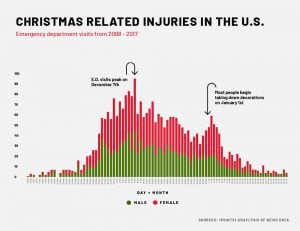Holiday hazards and their impact on hospitals
The holidays are here and while most of us are enjoying time with our loved ones and kicking back, hospital staff are about to get busier. It has been well noted in research that the most wonderful time of the year can also be the most dangerous, with some alarming safety statistics worldwide. We’ve outlined some of the biggest holiday hazards and how they can impact hospitals.
1. There is a 25% increase in trauma patients being brought to Australian Emergency Departments between November and January.
One hospital’s cases of trauma during the holiday season in 2018 included a young man with internal injuries after a brawl in a nightclub, an elderly lady with fractures ribs from a fall while playing with her grandchildren, and a female passenger brought in by helicopter after a head-on collision with a car.
2. In the UK, people are 50% more likely to die in a fire during Christmas than any other time of the year.
Fire plays a significant role in many Christmas traditions, including transport for Santa, roasting chestnuts, and lighting candles. These increase the risk of an accidental fire in the family home, one of the largest holiday hazards. Other risks include dry Christmas trees, old electrical lights, and distracted cooking.
3. Cardiac-related deaths increase during the Christmas holidays around the world.
Research in several countries which celebrate Christmas has confirmed a rise in heart attacks during Christmas Eve, Christmas Day, and New Year’s Eve. Swedish researchers attributed the rise to emotional distress, while USA researchers suggested that patients delay seeking medical attention during the holidays more often and overindulge salty foods and alcohol.
4. The most common Christmas-related injuries in the USA are all related to putting up and taking down decorations.
Patients received these injuries from falling off ladders as they try to put up Christmas lights, cutting hands on broken ornaments, and back sprains/strain from hauling Christmas trees. During the 2016 holiday season, the U.S. Consumer Product Safety Commission reported that there were 18,400 injuries related to holiday decorating at emergency rooms across the USA.
5. Ambulance attendances for alcohol intoxication doubles in Australia during the Christmas public holiday.
Drinking with colleagues, friends, and family is a common holiday tradition in many parts of the world. In Britain, 265 million pints of pure alcohol are drunk during December. In addition to alcohol poisoning, an increase in alcohol intake can lead to more falls, accidents, violence, and traffic collisions.
6. Hospital staff are likely to be more stressed over the Christmas season.
Unlike most professions, hospital staff including nurses, doctors, and reception staff are required to continue their role throughout the holidays. The increase in patient admissions, understaffing, and time spent away from family can contribute to significant stress on hospital staff. This stress and hectic schedule can lead to more medication errors, which is a significant patient safety risk. Violence against nurses is on the rise, and can be a particular problem during the holidays; Emergency Departments are more crowded, patients and their families are desperate to leave, and alcohol-related admissions are common.
This Christmas season, remember to look out for holiday hazards —no one wants to spend Christmas in the hospital. And a big “thank you” to all the nurses, doctors, and other hospital staff who dedicate their lives to making us safe during the Christmas season and all year long.

References:
- Jamieson, J. & Hendel, S. (2018). Christmas in a hospital’s trauma unit means fractures, head injuries and stab wounds. The Conversation. Australia. http://www.abc.net.au/news/2018-12-24/christmas-in-a-hospitals-trauma-unit-means-stab-wounds-fracture/10645584
- National Accident Hotline. 12 hazards of Christmas. United Kingdom. http://www.national-accident-helpline.co.uk/accident-claims/12-hazards-of-christmas
- Mohammad et al. (2018). Christmas, national holidays, sport events, and time factors as triggers of acute myocardial infarction: SWEDEHEART observational study 1998-2013. BMJ. United Kingdom. http://www.bmj.com/content/363/bmj.k4811
- Hedgpeth, D. (2018). The happiest time of the year can also be dangerous. The Washington Post. USA. http://www.washingtonpost.com/dc-md-va/2018/12/18/happiest-time-year-can-also-be-dangerous/
- Kloner, R A. (2004). The “Merry Christmas Coronary” and “Happy New Year Heart Attack” Phenomenon. Circulation. USA. http://ahajournals.org/doi/full/10.1161/01.cir.0000151786.03797.18
- Alcohol and Drug Foundation. (2017). The sobering truth about the ‘silly season’. Australia. http://adf.org.au/insights/silly-season/
- Gooch, K. (2015). 3 steps to improve the lives of nurses through the holidays. Becker’s Hospital Review. USA. http://www.beckershospitalreview.com/human-resources/3-steps-to-improve-the-lives-of-nurses-through-the-holidays.html
- Thompson, G. (2019). Rates of violence against nurses in hospitals increasing rapidly. Australian Broadcasting Corporation. Australia. http://www.abc.net.au/news/2019-06-11/rates-of-violence-against-nurses-rising-rapildy/11196716

